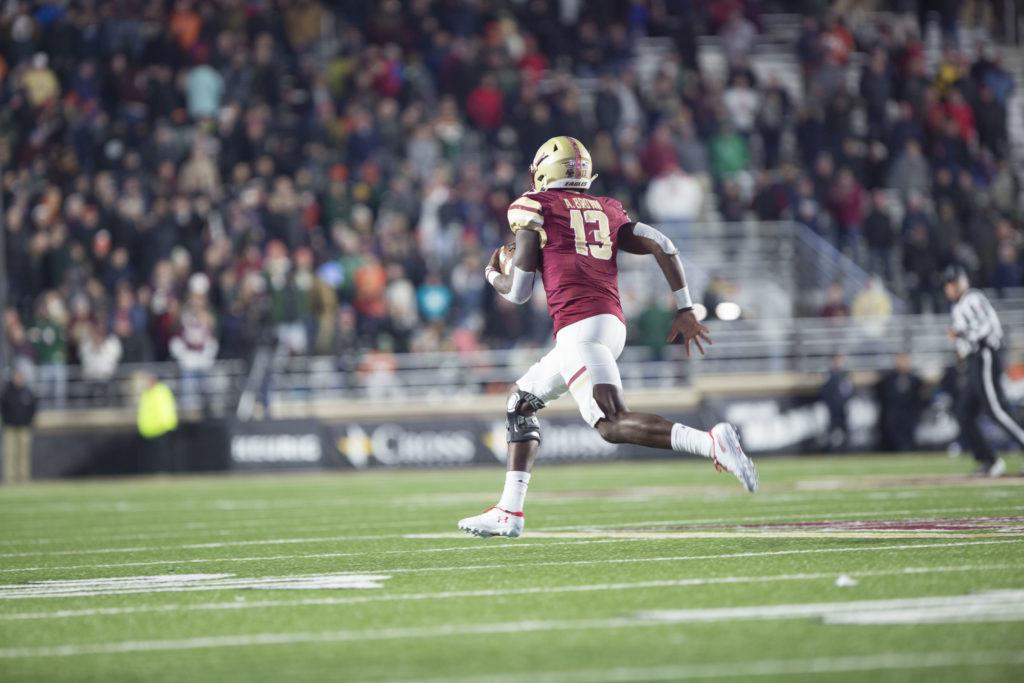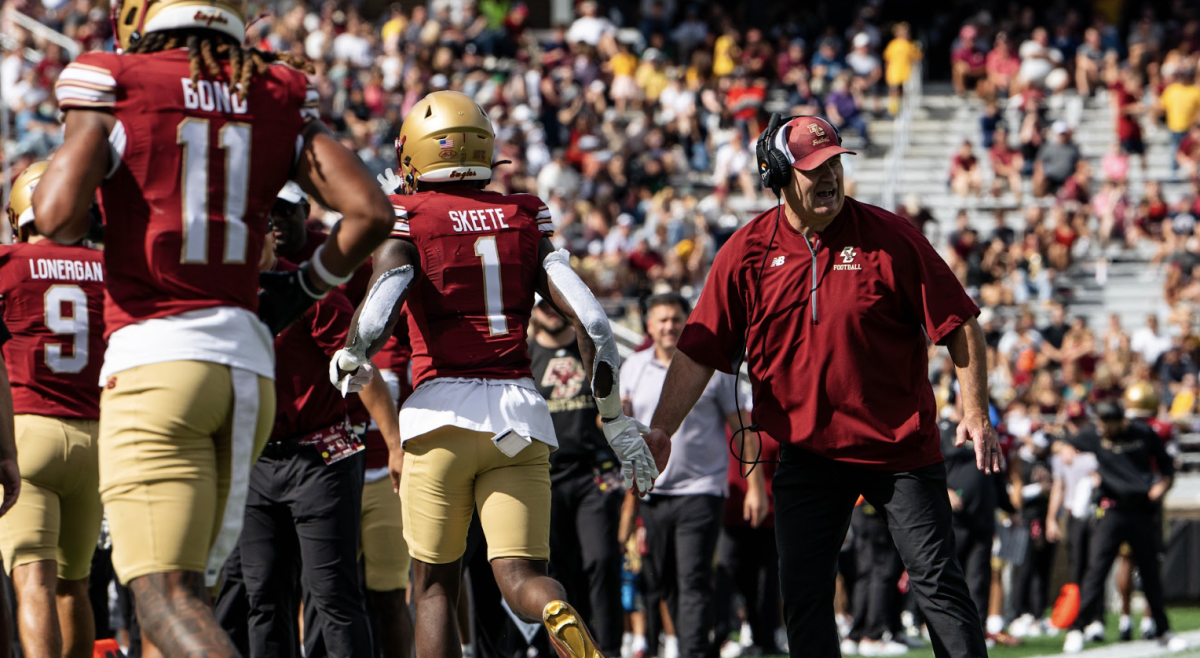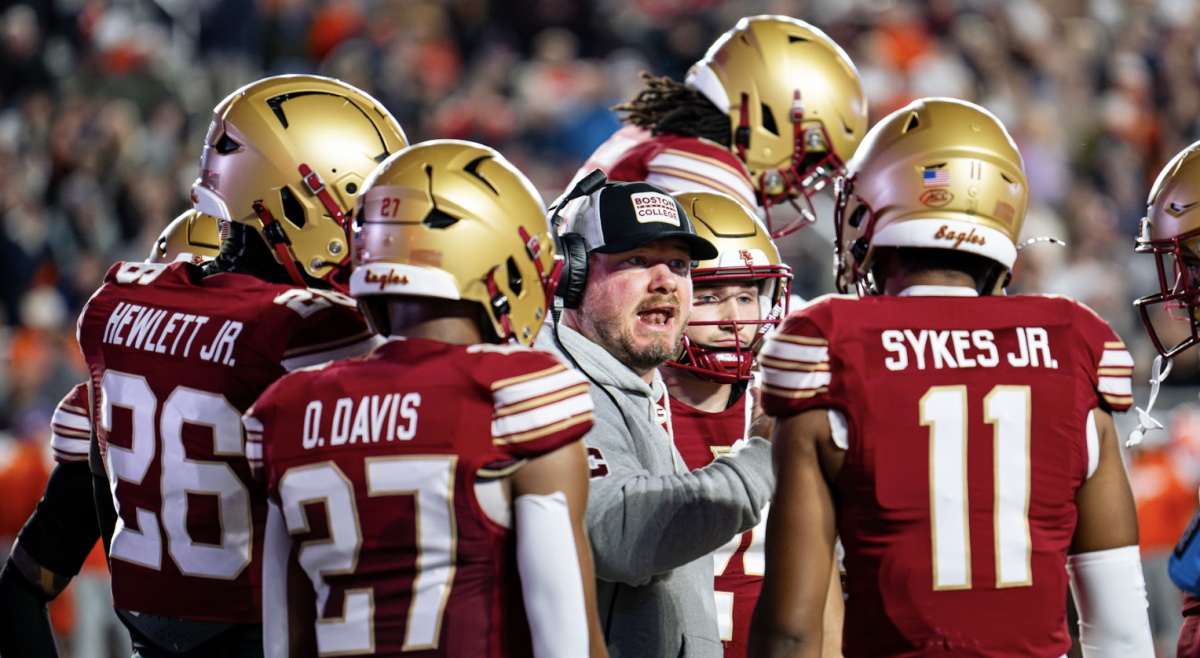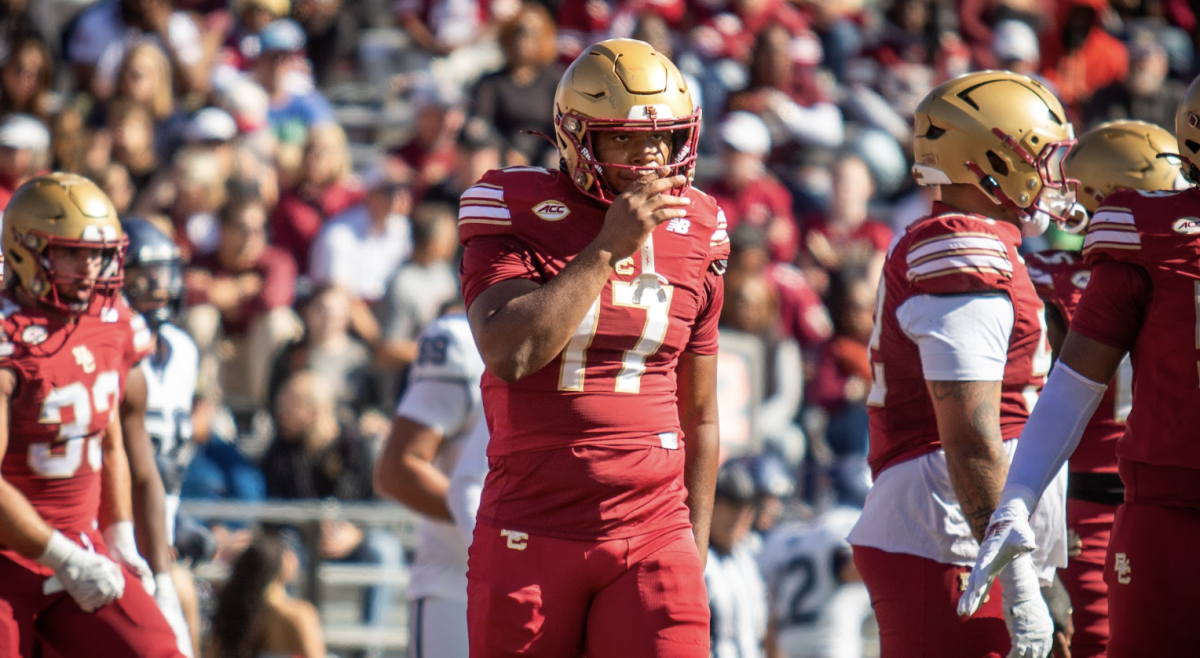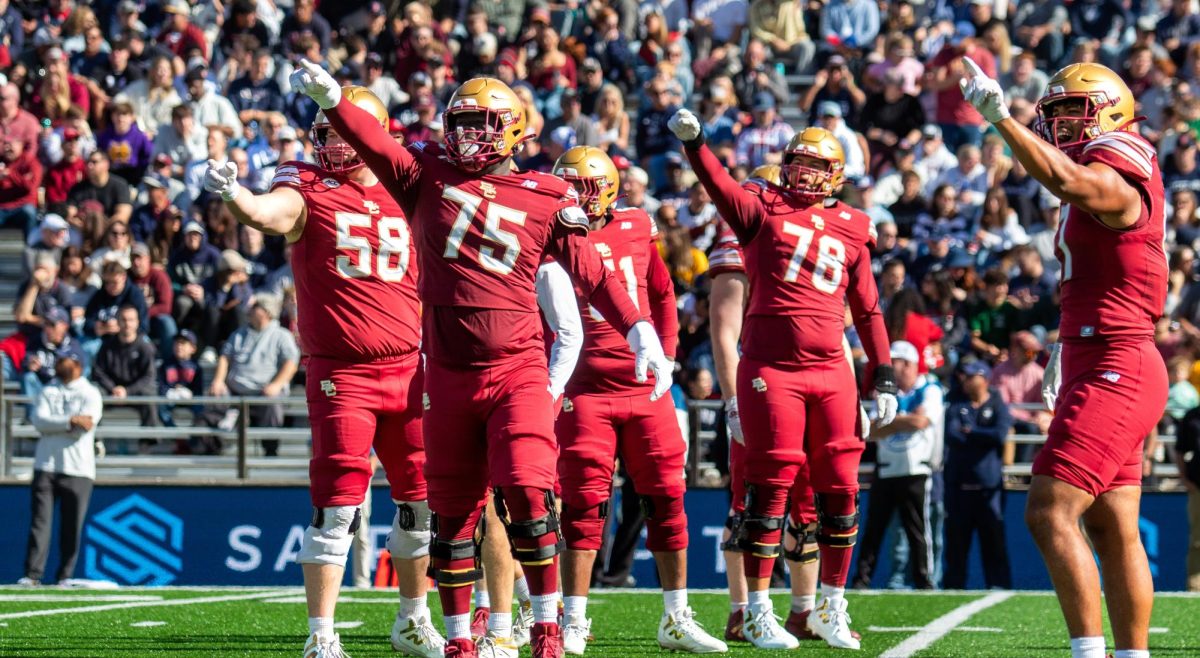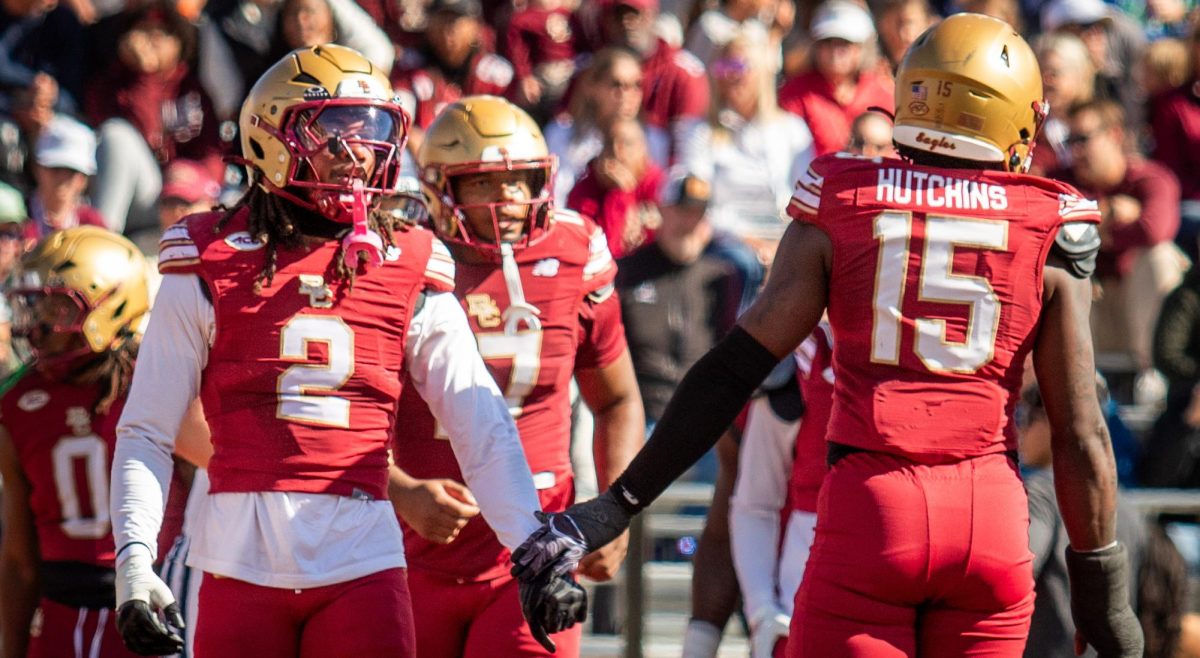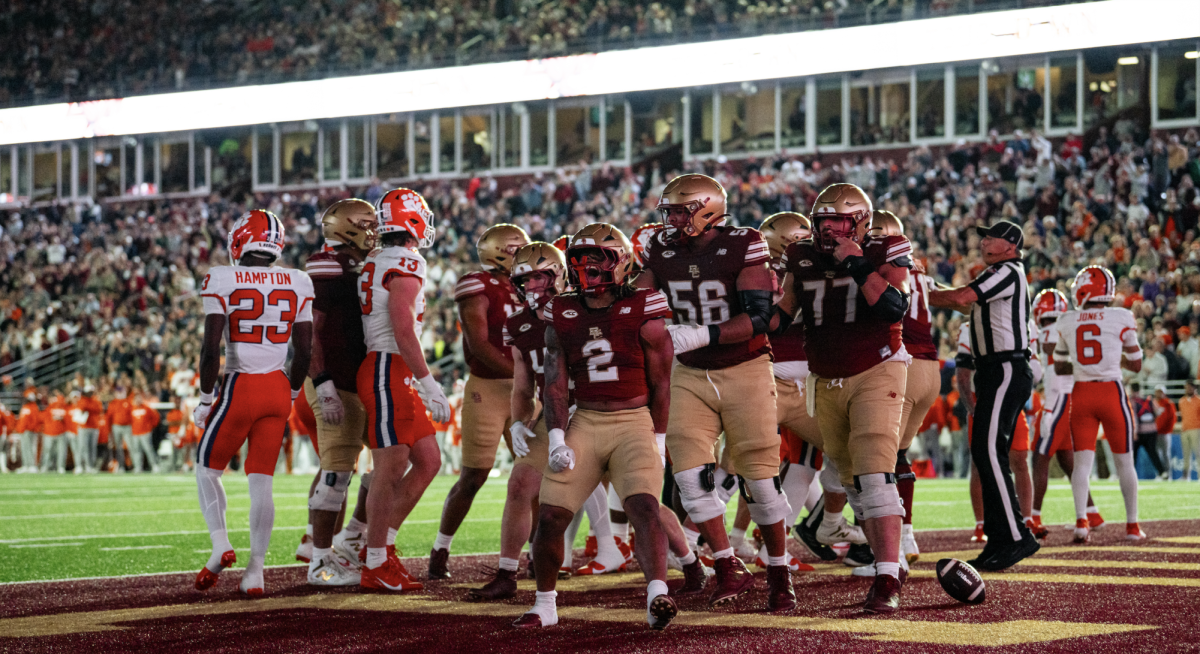Boston College football rolled out its highest scoring offense since 1993, cracked the AP Poll for the first time in a decade, defeated both Miami and Virginia Tech in the same season—something that hadn’t happened since 2007—made its first-ever appearance in the College Football Playoff rankings, hosted College GameDay with legitimate ACC title hopes, and boasted 13 All-ACC selections, the second most of any team in the conference. And yet, for the fifth time in the past six years, BC is on the brink of another 7-6 season.
Quite simply, the 2018 campaign was a roller coaster, one with a particularly sharp drop. Standing at 7-2 and No. 17 in the country—the Eagles’ highest ranking since 2007—many pegged BC as the only ACC team capable of dethroning three-time defending conference champion Clemson. Even though BC was a three-score underdog and the Tigers were averaging 60 points per game in their past four contests, there was the slightest hope on the Heights that the Eagles’ biggest game of the decade would yield an upset.
Instead, starting quarterback Anthony Brown suffered an internal body injury on BC’s sixth play of the game, sidelining him for the rest of the night. The Eagles scored on a 74-yard Michael Walker punt return, but never found the end zone on offense, losing both the game, 27-7, and any shot at making the ACC Championship. That’s when everything started to unravel. A controversial fourth down decision in Tallahassee and a defensive breakdown on Senior Day cost the Eagles their final two games of the regular season and a high-profile bowl game.
Now, BC (7-5, 4-4 Atlantic Coast) is set to play No. 23 Boise State (10-3, 8-2 Mountain West) in the SERVPRO First Responder Bowl, eying just its second win over a ranked opponent under head coach Steve Addazio (1-15 previously)—who received a two-year extension through the 2022 season on Dec. 11. You know the narrative, but here’s how the Eagles ended up in Dallas, by the numbers.
Baystate Blowouts
When BC released its complete schedule last January, it became abundantly clear that the Eagles would get off to their first 2-0 start in three years. With Massachusetts and the Patriot League’s Holy Cross on tap, Addazio and Co. were in line for a couple of big-time blowouts—and that’s exactly what they got. In fact, in each of those two games, the Eagles poured on 55-plus points and at least 598 yards of total offense. To put that in perspective, the scoring outburst marked the first time in program history that BC had racked up 48 or more points in the first two games of the year.
In 2017, Addazio and offensive coordinator Scot Loeffler did everything they could to strike a balance on offense, but against UMass, the Eagles looked just as, if not more, explosive through the air. Playing his first game since tearing his ACL against North Carolina State the previous November, Brown completed 15-of-21 pass attempts for 279 yards and four touchdowns in just one half of play—both of which were career highs. His best friend and tailback, A.J. Dillon, rounded out the offense. In one half of work, the Heisman hopeful carried the ball 20 times for 98 yards, in addition to recording his first-ever reception and touchdown catch. When all was said and done, the Eagles clocked out with 622 yards of total offense, eclipsing 300 yards passing for the first time under Addazio.

One week later, though, it was Dillon who stole the spotlight. All it took was 13 minutes and 47 seconds for the sophomore to turn Heisman voters’ heads. After failing to record a rushing touchdown in the season opener, the New London, Conn. native reached the end zone on the ground three times in first quarter of BC’s old-school reunion with Holy Cross. Dillon left the game before the end of the opening frame, having carried the ball six times for 149 yards and a trio of scores. That’s right—he averaged 24.8 yards per carry. As a whole, the offense strung together three-consecutive drives of 60-plus yards, all of which spanned less than five plays and 80 seconds. The second- and third-stringers kept the Eagles’ foot on the gas, cruising the rest of the way to a 62-14 victory.
Back and Better Than Ever
Brown’s health was a major concern heading into the 2018 campaign. After all, he wasn’t just returning from an ACL injury. Earlier in the 2017 season, the Cliffwood, N.J. native was hampered by shoulder problems and, at times, struggled to protect his body when on the run. But when Week One rolled around, Brown was back and better than ever. The redshirt sophomore was making all of the necessary throws: short, intermediate, long, and even those that required him to move outside the pocket. The moment of truth came in the season opener when the underclassman gunslinger faked a handoff and trailed to his right, eying Ray Maarten down the seam. Without hesitation, he fired a 33-yard touchdown strike to his tight end, while absorbing a hit from a Minutemen linebacker. Confident in his body, Brown looked like a different quarterback.

His success wasn’t short-lived either—actually, it carried into ACC play. After only attempting and completing two passes in his brief appearance against Holy Cross, Brown lit up the box score at Wake Forest in Week Three, stitching together what remains the best game of his career—at least on paper. The redshirt sophomore completed 64 percent of his pass attempts for a career-high 304 yards and five touchdowns, three of which came in the second half. Every time the Demon Deacons threatened, Brown reached into his back pocket for another big-time throw. His monster day through the air vaulted BC to a 3-0 start and its first appearance in the AP Poll since 2008.
Through three weeks of play, Brown led the nation with a 240.2 passer rating and ranked second in the country in yards per pass attempt (13.0). Of course, those kinds of stats were hardly sustainable, but the redshirt sophomore still finished year with 20 passing touchdowns—the most in a regular season by a BC quarterback since Matt Ryan in 2007—and improved in every statistical category, most notably completion percentage (jumped from 51.9 to 55.4 percent).
Explosive, but Inconsistent
The Eagles ended the regular season with the 41st-highest scoring offense in the country, but for a while, they ranked among the top-20 most potent units in the FBS. After racking up a combined 117 points in the first two weeks of the season, BC poured on 41 at Wake Forest—eclipsing the 40-point mark against an ACC opponent for the fourth time in the past two seasons. Over the course of the first three games of the 2018 campaign, the Eagles were averaging 52.7 points and 561.5 yards per game, both of which were good for seventh in the nation. But as Brown and Dillon came crashing down to earth at Purdue, so did the entire Eagles offense. BC mustered just 13 points in its loss to the Boilermakers, illustrating just how inconsistent Loeffler’s offense really was.
Naturally, the Eagles bounced back with a 45-point outburst against Temple, only to squander an opportunity on the road at N.C. State. In Raleigh, BC—missing Dillon, who was sitting out the first of two games with an ankle injury—recorded just 23 points and 318 total yards of offense. Up until their final drive of the third quarter, the Eagles were 0-of-9 on third and fourth downs and had logged a mere 109 yards and three points—an abysmal performance for any offense, let alone one of the premier scoring attacks in the country at the time. Loeffler, who throughout the season inexplicably reverted to predictable run-run-pass play-calling—an offensive strategy that subverted his typically aggressive and methodical scheme—was partially to blame.

Yet, just when it looked like BC was headed in the wrong direction, the offense rebounded, averaging 32 points per game the next three weeks of play. That said, even some of those games have to be taken with a grain of salt, considering that both VTech and Louisville conceded more than 30 points per game on the year. As soon as Clemson came to town, BC’s offense—albeit hurting—tanked. The Eagles put up just 49 total points in the final three weeks of the regular season, failing to finish drives and turning the ball over six times in the process. Although BC still hit its fair share of big plays, it struggled to string together two halves of complete football down the stretch of the year. While the Eagles averaged 39.8 points per game in the first half the season, they managed just 24.2 points per contest in the latter portion of play.
The Running Back Carousel
Dillon entered the season as a legitimate Heisman Trophy candidate. After all, the bruising and deceptively quick tailback rushed for 1,256 yards and 13 touchdowns in the final seven games of his freshman season and was named ACC Preseason Player of the Year prior to the start of the 2018 campaign. Even though it didn’t do Dillon’s Heisman odds any favors, Addazio used the sophomore sparingly in the first two games of the year. After that, though, he was the definition of a workhorse. Dillon carried the ball 80 times throughout the next three games and perhaps would have topped the 85 mark had he not suffered an ankle injury a minute into the second half of the Eagles’ Homecoming game against Temple.

Without the sophomore, Addazio turned to X-back Ben Glines, who was more than serviceable in replacement. In fact, it was Glines that fended off the Owls at home with 23 carries and 120 yards in what was essentially his collegiate debut at the running back position. The ensuing two weeks, the 6-foot-2 junior turned 33 rushes into 197 yards and two touchdowns. Eventually, his workload was split with freshman David Bailey, a powerful back that in many ways fits Dillon’s mold. Throw in Travis Levy on third down, and the Eagles’ rushing attack was almost as effective as it was with Dillon in the backfield. Given that Glines and Bailey reached the century mark, it was only right that Levy joined them—his time came at VTech.
After Dillon—who left the final four games of the regular season early with injury—limped off the field, Levy took over in the backfield. The shifty sophomore proved that he’s more than just a receiving back, rushing for a career-high 75 yards and two touchdowns to lead BC to its third-straight victory, a win that brought College GameDay to Chestnut Hill. Between Dillon, Glines, Bailey, and Levy, the Eagles had one of the more versatile running back rooms in the nation. Unfortunately for BC fans, the individual backs were hardly used in conjunction, even when Dillon was admittingly far from 100 percent.
Disciplinary Issues
Last year, Addazio took pride in the fact that the Eagles were one of the least penalized teams in the FBS, and rightfully so. The third-least penalized team in the country, BC was only flagged 3.6 times per game in 2017, a grand improvement compared to the 6.9 average it posted the previous year. But in 2018, the Eagles took a big step back in the on-field discipline department. Much to Addazio’s chagrin, BC committed 6.4 infractions per contest this season, dropping all the way to 77th in the nation in penalties per game. Often, the flags came at the expense at those in the trenches. For instance, in the final contest of the regular season, the Eagles jumped offsides six times. Syracuse only accepted four of those penalties, but the lack of discipline was still blatantly apparent.
At its lowest, BC was even flagged for targeting on a few separate occasions. Whether it was out of pure frustration or simply by mistake, both Lukas Denis and Max Richardson were ejected for targeting opponents’ heads in Week Five and Six, respectively. Will Harris nearly got the boot against Miami after apparently lowering his head and barreling through Miami wide receiver Darrell Langham in the end zone. It’s the little things like penalties that can make the difference between a seven-win season and an eight or nine-win campaign.
Second-Half Defense
As good as BC was offensively throughout the first half of the season, it was uncharacteristically bad on the other side of the ball—and you wouldn’t necessarily be able to tell on paper. Following the first two games of the season, the Eagles conceded 467.3 yards per game amid the ensuing four contests. To contextualize, Kent State—which currently boasts the 13th-worst total defense in the country—allowed an identical 467.3 yards per game all year long. Simultaneously, however, BC was forcing turnovers. Zach Allen emerged as a top-15 NFL prospect, and Wyatt Ray recorded four sacks at Wake Forest, earning Walter Camp Player of the Week honors. Not to mention that Hamp Cheevers was channeling his inner Lukas Denis for the nation lead in interceptions.
Ultimately, Jim Reid’s defense snapped back into form for the Eagles’ best three-game stretch of the season, giving up an average of 304.7 yards per game against the likes of Louisville, Miami, and VTech. Led by Allen and Cheevers, BC’s highlight-reel defense was particularly effective in the back half of play. During that three-game span, the Eagles conceded a combined seven second-half points. The unit even held its own against Clemson. Despite being on the field for 35 and a half minutes, BC kept the No. 2 Tigers under 450 yards of total offense, a moral victory in itself, considering that Clemson came into the game having averaged 588.5 yards in its previous four contests.

But, like the rest of the team, Reid’s defense fell apart in the last two weeks of the season, allowing 475-plus yards to both an underachieving Florida State offense and a dangerous Syracuse team—one that was seeking revenge after enduring a four-touchdown blowout at the Carrier Dome in 2017. All in all, for a defense that could very well send four or five players to the NFL Draft, its mid-October to early November play hinted that—when at its best—it was just as dominant as any unit in the ACC.
A Polarizing Third Phase of the Game
At the beginning of the year, one of the only tangible flaws tied to BC was its special teams. Entering their Week Five matchup at N.C. State, the Eagles had three blocked punts returned for touchdowns—two of which came against Holy Cross—three botched snaps while in punt formation, four missed extra points, a muffed punt, and a fumble on a kickoff return that gifted the opposition with a scoop and score touchdown. Of course, that week, everything changed. Kevin Bletzer blocked a field goal, and Mike Palmer blocked a punt, which conveniently bounced into the end zone for a Levy recovery and touchdown.
From then on, BC still had its gaffes from time to time—Michael Walker kick return fumbles and Colton Lichtenberg missed field goals—but it was special teams that yielded some of the team’s best and brightest moments of the season. Walker’s 74-yard punt return touchdown against Clemson will go down as one of the more memorable plays in program history, as it gifted the Eagles’ with a 7-3 lead over the undefeated Tigers under the lights of a sold out Alumni Stadium in what was easily the biggest game of the decade for BC Athletics. By season’s end, BC ranked inside the top 20 in kick and punt return yards and was tied for fifth in blocked kicks. Just like the year itself, the Eagles’ special teams were nothing short of a roller coaster.
Featured Image by Julia Hopkins / Heights Senior Staff
Graphics by Andy Backstrom and Bradley Smart / Heights Editors

